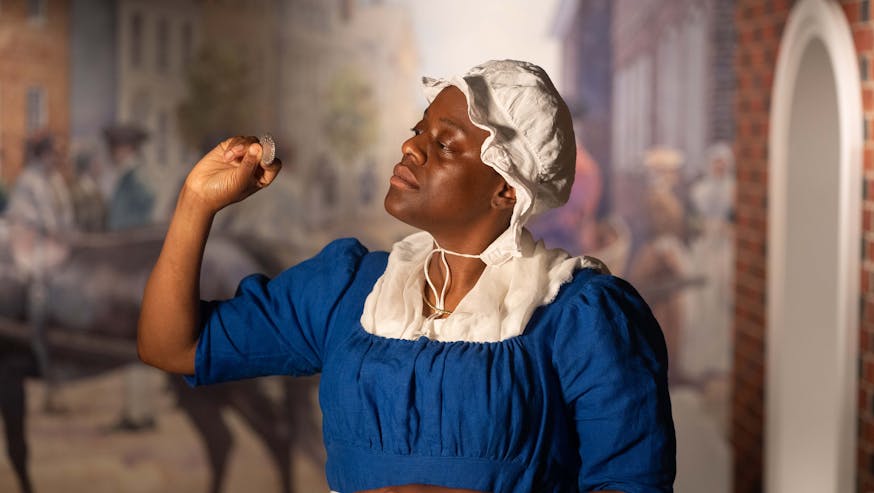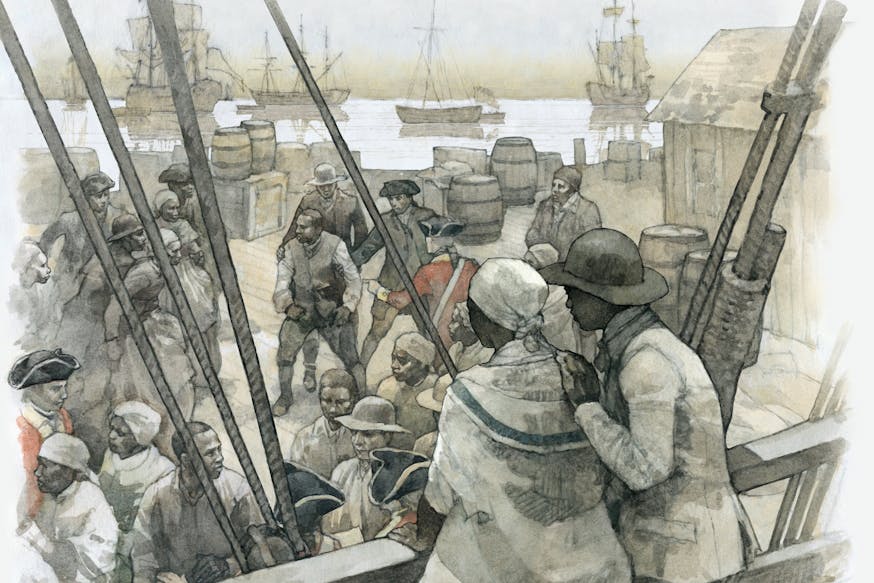Read the Revolution
The Dawn of Detroit
February 10, 2021
Purchase the book from The New Press.
In The Dawn of Detroit: A Chronicle of Slavery and Freedom in the City on the Straits, Dr. Tiya Miles explores not just the early history of an American city but also the profound influence of race and slavery on that city’s development. “Please rip your mental map in half,” she asks, “and turn it upside down — the one that sees Detroit in Michigan, Michigan in the Midwest, the Midwest as fly-over country in the United States of America.” Instead, we should view Detroit as it was in the 1700s: as the center of a global trading network, a meeting place for people from different cultures, and a home to free and enslaved people of Native American and African descent who labored and facilitated trade. What did Detroit, Michigan, look like to these people just as the American Revolution was beginning? In the Museum’s online interactive feature Finding Freedom and through the Museum’s Black History Month celebrations, we explore similar stories of people caught in the midst of a global revolution.
In this excerpt from a chapter on “The War for Liberty (1774-1783),” Miles takes us into the trade shop of a pair of Detroit merchants on a dark night in 1774. In places like Boston and Philadelphia, Revolutionary rhetoric and protests were pushing people to the brink of open rebellion. But in Detroit, a town defined as part of the American Northwest Territory with stronger connections to British Canada after The Quebec Act of 1774, most people had more immediate legal concerns on their minds. Enter Ann Wyley.
Excerpt
What was going through Ann Wyley’s mind when she entered and burgled the furrier shop of two of Detroit’s most successful merchants? Certainly not that she and her accomplice, the Frenchman Jean Baptiste Contencineau, would escape unpunished if caught for theft. Like most British businessmen in the bustling frontier maritime town, James Abbott and Thomas Finchley, targets of the break-in, dealt in furs and imported goods. Their job was to procure skins from local hunters or middlemen and ship those pelts to purchasers in the East in exchange for supplies; they then sold or distributed manufactured items to customers and American Indian trade partners. The pair operated a shop located near a host of others along the northern bank of the Detroit River, the liquid-gold main street of colonial Fort Detroit. And in addition to co-owning the store itself, Abbott and Finchley co-owned Ann Wyley, an enslaved woman of African descent. Abbott was an Irishman by birth whose arrival in 1768 had been timed to take advantage of opportunities afforded by the British assumption of former French posts. Finchley, his business partner, is a more reclusive figure in the records of early Detroit, who appears only infrequently in conjunction with shorthand notations about the pair’s firm. Both men were slaveholders, as were other members of the newly arrived British merchant elite. Between Pontiac’s Rebellion and the American Revolutionary War, these men joined their French and Euro-Indian mixed-race counterparts in the capitalist enterprise of the Great Lakes skin trade, acquiring the pelts of beasts and the bodies of humans to build wealth and influence. Between the waning years of the French period and the rise of the British period, the ratio of indigenous to black slaves tilted only slightly. An approximate count of the Ste. Anne’s parish records indicates sixty-four Natives to five blacks in the 1760s and forty-six Natives to eight blacks in the 1770s. It would take a revolution and shifting political balance of power for numbers of enslaved blacks to substantially increase in a town defined as part of the American Northwest Territory.
Ann Wyley was among few blacks, enslaved or free, living in Detroit in the early 1770s. How the firm of Abbott & Finchley came to count her among their assets is unknown. Equally mysterious are the precise details of what took place on the night the storehouse was robbed, as the fragmented testimony of participants varied at the time, and the testimony of Ann Wyley, portrayed as the instigator by her co-conspirator, was not preserved in the record. In the spring and summer of 1774, a series of petty thefts had been taking place inside the walls of the fort, wrangling the frayed nerves and thinning the pocketbooks of resident merchants. Ann Wyley, “a negro slave” of Abbott & Finchley, Jean Contencineau, “a Canadian of humble station” in the employ of Abbott & Finchley, and Charles Landry, another laborer at the firm who worked alongside Jean packing peltry, were all suspected as perpetrators in “a system of small pilfering that had been going on for some time.” The most dramatic of these crimes—the burglary of Abbott & Finchley’s story apparently facilitated by an act of arson—was the final straw, the bold incident that led to a government crackdown, Ann Wyley’s jailing, and Jean Contencineau’s death. The violation of property rights within the heavily guarded fort unnerved the moneyed class in Detroit, and “a feeling prevailed that there could be no security until such worthless characters were adequately punished.”
In this heist that set the wheels of Detroit's barebones justice system in motion, “eight pounds of beaver skins, two otter skins, and some raccoon skins, to the value of four pounds sterling" along with a handful of domestic items and "little knives" had been stolen. Of the spoils, Ann Wyley had come away with "a purse containing six guineas, the property of James Abbot…which purse were found on [her] person,” as well as “a handkerchief, containing two pair of women’s shoes and a piece of flannel.”
Was Wyley making a statement of political import through her illegal action? Did she wish to adorn herself with the feminine items now in her possession, to embellish the rough apparel provided by her owners that likely marked her inferior status as a slave? Did she think she could improve her material condition by taking the goods and selling them on the illicit market? Or was there a deeply emotional element motivating her actions? Perhaps Ann had bonded with or felt indebted to her accomplice, Contencineau, who worked in the shop as a "servant," and might have been indentured (bound for a period of years) to Abbott & Finchley's firm. Perhaps Ann longed to strike a blow against her owners where she knew it would hurt the most—their commercial enterprise, the other valuable "things" they owned.
Whatever her reasons for taking the risk, Wyley, along with her accomplice, faced dire consequences for her actions. Arrested by the authorities, the duo faced indictment for "subtilly, privily [and] craftily ... steal[ing], tak[ing], and convey[ing] away" the "goods and chattels of the said Abbot and Finchley" as well as "attempting to set fire to the house of the said Abbot and Finchley." Confined to the barracks where prisoners were kept in the fort, the unlikely pair awaited trial for nearly two years, an expanse of time during which Wyley stood at the mercy of her military jailers, much like the unnamed “Panis” slave woman who was similarly imprisoned there for reasons unknown in 1763.
In the spring of 1776 Ann Wyley and Jean Contencineau finally had their day in court, but the proceedings of that court were far from regular. The passage of the Quebec Act in 1774 had established the boundaries of British Canada and included Michigan within the legal jurisdiction of Quebec. Officials in Quebec then appointed military and civil leaders to run the distant posts. In 1775, Henry Hamilton, a captain in the British army described as "overbearing and supercilious," became lieutenant governor of Detroit. As the town’s chief civil leader, Hamilton worked closely with Philip Dejean, Detroit’s notary and justice of the peace since 1767, who was suspected of being “a bankrupt merchant from Montreal…that came west to better his fortune by leaving his debts and creditors behind.” Dejean’s mandate was never clearly defined by British officials in Quebec; nor were the legal rights of Detroiters in relation to local governance. But there was a sense among residents that Dejean’s nebulous eauthority did not grant him the right to judge serious offenses of exact harsh punishments.
[…]
Contencineau represented himself as someone who had made the mistake in the petty pilfering of furs and knives, but who lacked the premeditation, insider knowledge, and craftiness of his black female companion. Upon further examination in a second statement to the court, Contencineau even suggested that Wyley had planned the fire, placing “some powder in a horn…together in a piece of cloth with a piece of tinder” and “while her master was dining” giving the kindling to Contencineau to “place it upon a piece of English cloth” in the storehouse. He stated further that “after the negress had given him the six dollars [from the cash box], the negress threw the box to him and said ‘Empty it and throw it in the fire.’”
In the scant pages of testimony that have survived the centuries, Ann Wyley is only attributed two lines of speech: a directive to her accomplice to hide the evidence, and her own paraphrased testimony in which she “declared that she had given the four silver dollar to Mr Cenette, one of the paper dollars to Mr Chatelain and the other to Mr C Enfant” and that she “had given three poudns in paper to Jean Countencineau, which said three pounds he carried to Samuel Denny” at her request. Ann Wyley, according to her testimony, was compensating Frenchmen of means with the stolen funds of her masters. Could she have been paying down debts, paying for silence, or purchasing the promise of future assistance in an even larger scheme, such as the theft of her own person from those who claimed her and her release from lifelong captivity?
Jean Contencineau’s attempt to shield himself from the worst of the charges did no good. He was viewed as equally culpable with Ann Wyley.
[…]
Dejean’s choice to punish Contencineau just as harshly as Wyley points to the quixotic character of slavery in colonial Detroit. This remote fort had nothing like the regimental racial systems of bondage found in larger and older slaveholding communities like South Carolina or even New York. A coherent system of laws organizing the practice of slavery did not exist and would never fully take shape in Detroit. The physical isolation and in-limbo jurisdictional quality of the western settlement, which lacked a stable, rationalized civilian government, led to a form of slavery that was fluid and even capricious until its eventual demise in the first decades of the 1800s.
Tiya Miles, The Dawn of Detroit: A Chronicle of Slavery and Freedom in the City of the Straits (The New Press, 2017) 65-70.
Read the Revolution is sponsored by The Haverford Trust Company.
Read the Revolution is published biweekly by the Museum of the American Revolution to inspire learning about the history of the American Revolution and its ongoing relevance.
Sign Up
Get biweekly Read the Revolution featured excerpts right to your inbox.
Tags
Learn More

Black History Month

Interactive Features


